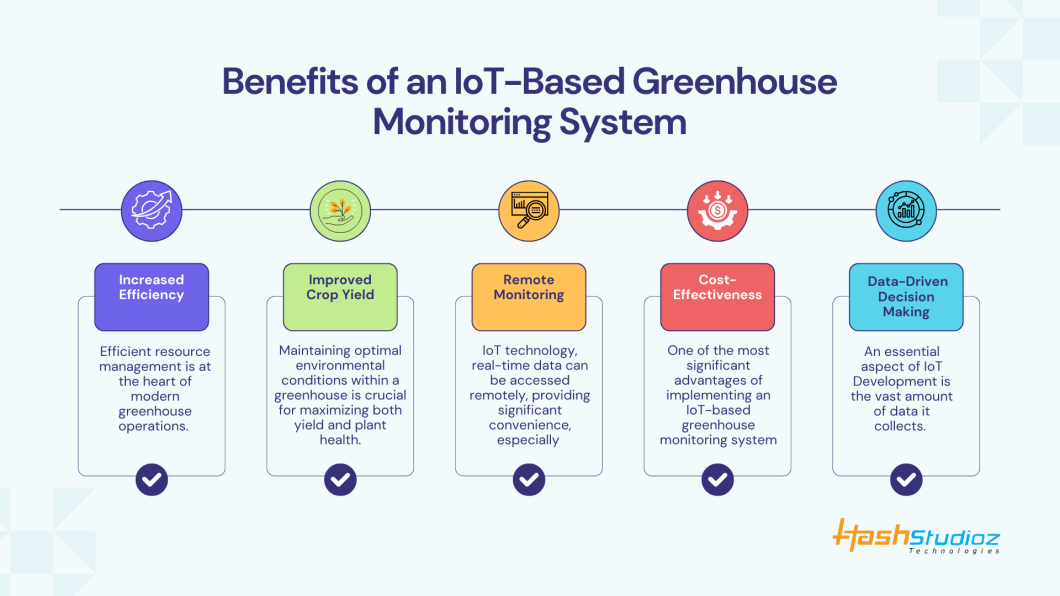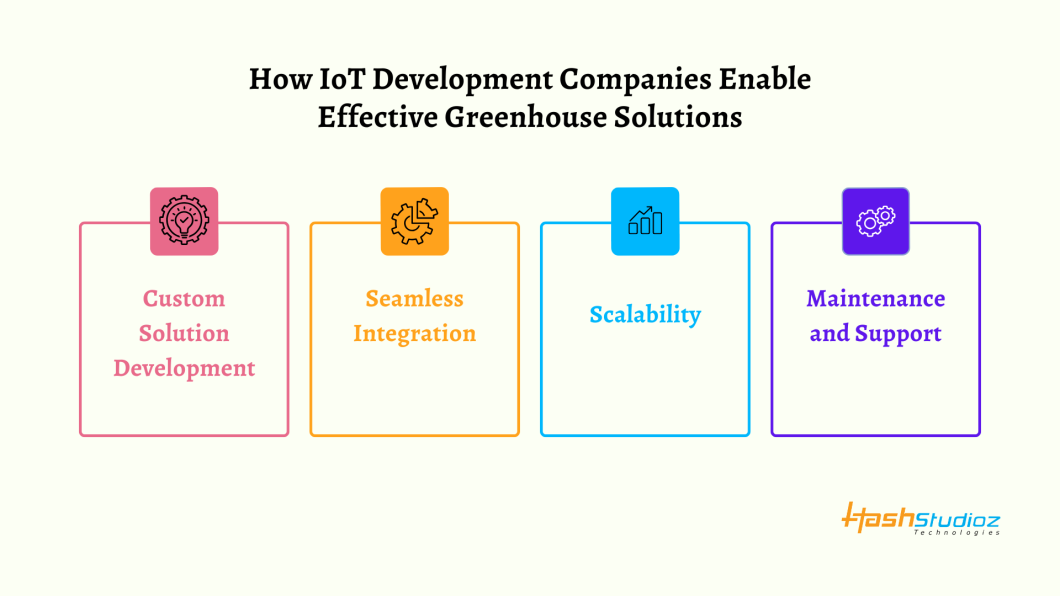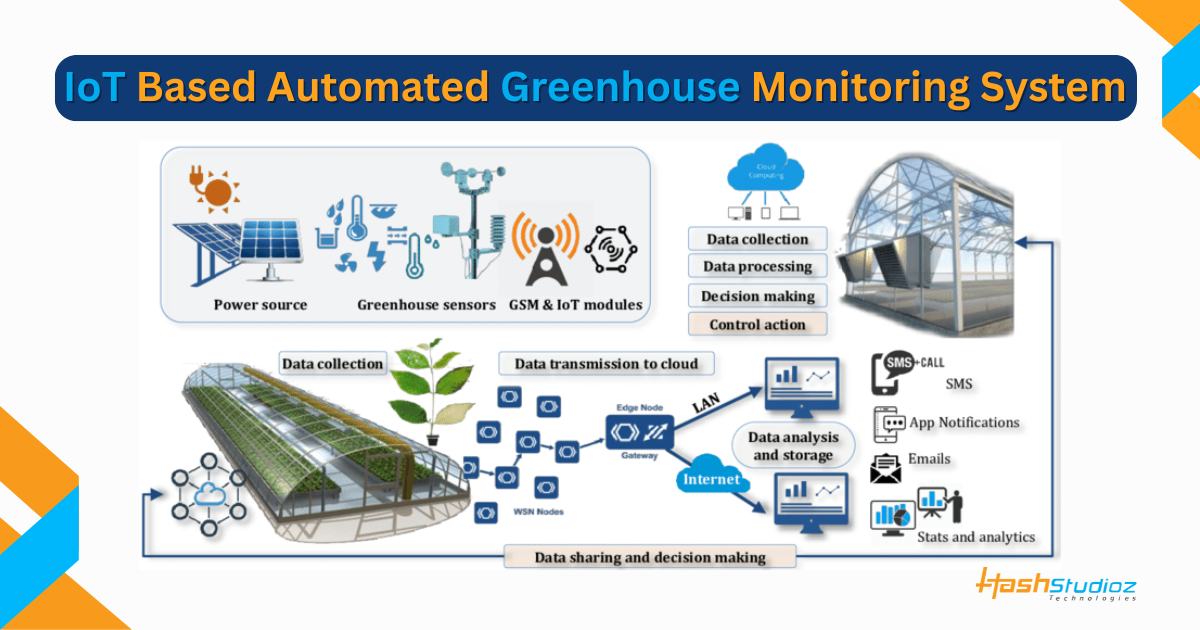The integration of the Internet of Things (IoT) into agriculture has brought about significant advancements, particularly in greenhouse farming. Greenhouses, which are used to cultivate plants in a controlled environment, require careful monitoring of several variables like temperature, humidity, soil moisture, light intensity, and air quality. Managing these factors manually can be a daunting and inefficient task. This is where an IoT-based automated greenhouse monitoring system comes into play, offering farmers real-time monitoring and automation that can enhance the efficiency and sustainability of their operations.
Table of Contents
What is an IoT-Based Automated Greenhouse Monitoring System?
An IoT-based automated greenhouse monitoring system uses interconnected sensors, devices, and cloud-based software to continuously monitor and manage the conditions inside a greenhouse. The sensors collect data related to environmental factors, while automated systems make real-time adjustments, such as controlling ventilation, irrigation, or lighting.
In essence, the system allows farmers to remotely manage their greenhouse, optimize plant growth conditions, and reduce manual labor while ensuring efficient resource usage.
Key Components of the System:
- Sensors: These measure various environmental factors like temperature, humidity, soil moisture, light intensity, and CO2 levels.
- Actuators: Devices that automatically adjust variables such as watering schedules, temperature control, or lighting based on sensor inputs.
- Cloud Platform: A cloud-based interface where data is aggregated, analyzed, and accessed remotely, often with visual dashboards for easier management.
- Connectivity: IoT technology enables communication between devices, sensors, and the cloud platform through Wi-Fi, LoRaWAN, or cellular networks.
- Automation: Based on sensor data, the system triggers actions such as activating fans, turning on irrigation systems, or adjusting lights to maintain the optimal environment.
The main advantage of such systems is the seamless automation and real-time control it offers to greenhouse operators.
Benefits of an IoT-Based Greenhouse Monitoring System
An IoT-based greenhouse monitoring system is transforming agricultural practices by automating and enhancing the management of environmental conditions. Through interconnected sensors, real-time data collection, and automated systems, IoT technology ensures optimal greenhouse environments. Below, we explore the key benefits in more detail.
1. Increased Efficiency in Resource Management
Efficient resource management is at the heart of modern greenhouse operations. The integration of IoT Development ensures that resources such as water, energy, and nutrients are used optimally, leading to both economic savings and sustainability.
- Watering Efficiency: Water management is one of the most critical aspects of greenhouse farming. Excessive water usage leads to unnecessary expenses and waste. IoT-enabled automated irrigation systems allow farmers to control watering precisely using real-time data from soil moisture sensors. The system activates only when soil moisture falls below a predefined threshold, ensuring it delivers water only when necessary. This method significantly reduces water wastage compared to traditional irrigation techniques.
- Energy Savings: Temperature regulation and lighting in greenhouses typically consume a significant portion of energy. An IoT-based greenhouse monitoring system helps optimize both. Temperature and humidity sensors continuously monitor the greenhouse conditions. If the temperature deviates from the ideal range, the system can activate fans, adjust ventilation, or turn on heating or cooling systems to maintain an optimal climate. Similarly, the system can control lighting by adjusting the light intensity based on natural sunlight levels, ensuring energy is used only when necessary.

2. Improved Crop Yield and Quality
Maintaining optimal environmental conditions within a greenhouse is crucial for maximizing both yield and plant health. An IoT system’s continuous monitoring of multiple variables enables farmers to create an ideal growing environment for crops. This improves not just quantity but also quality.
- Optimal Growing Conditions: IoT systems track and control temperature, humidity, soil moisture, light intensity, and CO2 levels, ensuring that each variable stays within the range required for plant health. For instance, many crops need a specific range of humidity and temperature to germinate and thrive. By integrating these systems, greenhouse managers can ensure that crops are always growing under perfect conditions.
- Real-Time Alerts: Real-time alerts are one of the most powerful features of IoT-based greenhouse monitoring systems. These alerts are sent to the greenhouse operator when there is any deviation from the optimal conditions, whether it be a temperature spike, a drop in humidity, or a failure in irrigation.
3. Remote Monitoring and Control
With the advent of IoT Development, greenhouse owners and managers no longer need to be physically present on-site to monitor conditions or adjust systems. Through IoT technology, real-time data can be accessed remotely, providing significant convenience, especially for large-scale greenhouse operations.
- Access Anywhere, Anytime: The remote monitoring capability of IoT systems allows farmers to track their greenhouse operations from any location, using their smartphone, tablet, or computer. Whether they are at home, in the office, or even traveling, they can check live data such as soil moisture, temperature, and humidity levels. This remote access eliminates the need for constant physical supervision of greenhouse operations and allows managers to respond to issues quickly.
- Instant Alerts: IoT systems also feature real-time alert systems that notify greenhouse managers of any irregularities in the greenhouse environment. For example, if an actuator malfunction occurs, such as a temperature sensor failure or a watering system issue, the system sends an immediate alert. This allows managers to respond quickly, even when they are miles away from the greenhouse.
4. Cost-Effectiveness and Reduced Labor
One of the most significant advantages of implementing an IoT-based greenhouse monitoring system is the reduction in labor costs. By automating many of the routine tasks involved in greenhouse management, such as irrigation and environmental control, farmers can reduce the need for manual labor, resulting in both time and cost savings.
- Reduced Manual Labor: IoT systems eliminate the need for frequent manual interventions. For example, sensors automatically monitor soil moisture and activate irrigation systems when required. Similarly, temperature and humidity sensors adjust the climate control systems without human input. As a result, workers are freed from performing repetitive tasks and can focus on more critical duties such as crop inspection or pest control.
- Long-Term Savings: While there is an initial investment in setting up IoT systems, the long-term savings are substantial. IoT systems reduce resource wastage—such as over-watering and unnecessary energy consumption—resulting in lower utility bills. Additionally, labor costs decrease as a result of automation. Over time, these savings can offset the upfront investment in technology, making the system financially viable in the long run.
5. Data-Driven Decision Making
An essential aspect of IoT Development is the vast amount of data it collects. This data is invaluable for making informed decisions that can improve the operation and productivity of the greenhouse. With continuous data collection, greenhouse operators can gain deeper insights into how crops respond to different environmental conditions, how resources are being used, and where improvements can be made.
- Predictive Analytics: By utilizing the data collected from various sensors, IoT systems can perform predictive analytics. This allows farmers to anticipate and prevent potential issues before they arise. For example, predictive analytics might indicate that a particular temperature fluctuation could lead to poor crop performance. Based on this insight, the system can automatically adjust temperature settings or alert the farmer to make manual adjustments.
- Enhanced Decision Making; The wealth of data provided by IoT systems allows farmers to make more informed decisions. Instead of relying on gut feelings or outdated methods, they can analyze real-time data and make adjustments based on facts. For instance, by monitoring plant health and growth patterns, a greenhouse manager might adjust nutrient levels or environmental conditions to promote optimal growth for a specific crop.
How IoT Development Companies Enable Effective Greenhouse Solutions
While the benefits of an IoT-based automated greenhouse monitoring system are clear, developing and implementing such a system requires specialized knowledge and expertise. This is where partnering with an IoT Development Company can make all the difference. These companies bring the necessary technical knowledge and resources to create a custom solution that suits the unique needs of each greenhouse operation.
1. Custom Solution Development
An IoT Development Company can design and develop custom IoT solutions tailored to the specific needs of the greenhouse. This includes selecting the appropriate sensors, actuators, and cloud platforms, as well as integrating the system with existing infrastructure.
- Sensor Integration: The company will select the right sensors for monitoring various environmental factors such as soil moisture, temperature, and light intensity.
- Actuator Customization: They can design automation systems that trigger actions like adjusting irrigation schedules or opening ventilation systems based on real-time data.

2. Seamless Integration
For a greenhouse to function smoothly, various systems must work together. IoT Development Companies ensure that the sensors, actuators, and cloud platform communicate seamlessly.
- Integration with Existing Systems: If a greenhouse already has some automated systems in place, an IoT development company can integrate the new technology without disrupting existing workflows.
- Cloud Integration: The IoT systems are integrated with cloud-based software to store and analyze data, making it easily accessible to the greenhouse operators.
3. Scalability
As greenhouses expand, their needs evolve. A skilled IoT Development Company can design a scalable system that can accommodate additional sensors, more automation features, or larger operations.
- Future-Proofing: A well-designed IoT system can be easily scaled to incorporate new technologies or adapt to changes in the greenhouse’s needs over time.
- Adding More Sensors: As new types of sensors are developed, IoT development companies can easily add them to the system to monitor new variables that might improve plant health or yield.
4. Maintenance and Support
After the system is set up, IoT Development Companies provide ongoing support and maintenance to ensure that everything runs smoothly. This includes troubleshooting, software updates, and sensor calibration.
- System Monitoring: Regular monitoring and maintenance are crucial to ensure that sensors are calibrated correctly and that the system is functioning optimally.
- Technical Support: In the event of system failures or malfunctions, IoT companies provide technical support to resolve issues quickly, minimizing downtime.
Real-World Example of IoT in Greenhouses
Netafim and AeroFarms are leading examples of IoT-based greenhouse systems, showcasing the transformative potential of technology in agriculture. Netafim, known for its expertise in irrigation, uses IoT-enabled sensors to monitor and control irrigation, ensuring efficient water use and reducing waste. Similarly, AeroFarms leverages IoT for managing temperature, humidity, light, and CO2 levels in their indoor farming operations, optimizing plant growth conditions. These systems improve efficiency, sustainability, and crop yield, demonstrating the future of smart farming.
1. Netafim’s IoT-Enabled Irrigation Control
Netafim has integrated IoT technology into its irrigation systems to optimize water use in greenhouses and farms. Their smart irrigation solutions use sensors to monitor soil moisture levels in real time. A cloud-based platform processes the data and automatically adjusts irrigation schedules and water volumes, ensuring the system applies water only when necessary. This system greatly reduces water wastage and improves water efficiency by up to 50%. In areas where water scarcity is a concern, this system provides a sustainable solution to maintain healthy crops while conserving resources.
2. AeroFarms: Smart Environmental Control for Indoor Farming
AeroFarms uses a highly automated, IoT-powered system for their vertical farming operations. By deploying sensors that measure environmental factors like temperature, humidity, light intensity, and CO2 concentration, AeroFarms is able to create optimal growing conditions for plants. The real-time data gathered from these sensors allows the system to adjust the indoor environment automatically, ensuring plants receive the correct conditions for growth. This results in increased crop yields, reduced energy consumption, and minimized resource wastage, as environmental factors are fine-tuned continuously based on real-time data.
3. Efficiency in Resource Use Through IoT Integration
IoT-based greenhouse systems, like those implemented by Netafim and AeroFarms, provide a dramatic improvement in resource use efficiency. Farmers can precisely control water, energy, and nutrients based on real-time data from IoT sensors. For example, automated irrigation delivers water only when soil moisture levels drop below a set threshold, while the system dynamically adjusts light and temperature to maintain ideal conditions. These systems contribute to significant resource savings—AeroFarms uses 95% less water than traditional farming methods—helping farmers optimize yields while conserving vital resources.
4. Scalability and Flexibility in IoT-Based Systems
The scalability and flexibility of IoT-based greenhouse systems make them ideal for operations of varying sizes. AeroFarms, for example, scales its vertical farms without expanding its physical space. This lets it grow more crops in less area. Similarly, Netafim uses its irrigation technology in both small greenhouses and large farms. Its systems work well across different farm sizes. Farmers can scale systems up or down as needed. This increases efficiency, improves flexibility, and cuts costs. As a result, IoT solutions fit both small and large farming operations.
5. Sustainability and Environmental Impact
Sustainability is at the heart of IoT integration in agriculture. AeroFarms’ closed-loop indoor farming systems minimize the need for arable land, reducing the environmental footprint of crop production. The use of IoT allows for precise control of water, nutrients, and energy, ensuring that resources are not wasted. By collecting and analyzing real-time data, the system can optimize resource usage, reducing both environmental impact and operational costs. With 95% less water used and no need for pesticides, AeroFarms exemplifies how IoT in agriculture can help drive sustainability efforts while boosting productivity.
Why Choose HashStudioz for Your Greenhouse Automation?
At HashStudioz, we specialize in designing and deploying custom IoT greenhouse monitoring systems that help you manage your crops more intelligently, efficiently, and profitably.
We bring:
- Deep expertise in IoT and embedded systems
- Custom hardware–software integration
- Remote monitoring & automation solutions
- Data analytics and predictive maintenance features
Ready to build your smart greenhouse?
Get in touch with HashStudioz today to discuss your custom IoT solution. Let’s bring intelligence to your agriculture.
Conclusion
The integration of IoT Development into greenhouse operations has brought about significant advancements in agriculture. By automating key functions like irrigation, temperature control, and lighting, farmers can increase crop yields, reduce costs, and improve efficiency. Moreover, with real-time monitoring and remote access, the management of greenhouses becomes much easier, allowing for better decision-making and resource management.
Partnering with an IoT Development Company provides the technical expertise needed to develop, implement, and maintain an IoT-based greenhouse system tailored to the specific needs of each operation. As technology continues to evolve, the potential for IoT in agriculture will only grow, creating a smarter and more sustainable future for farming.

